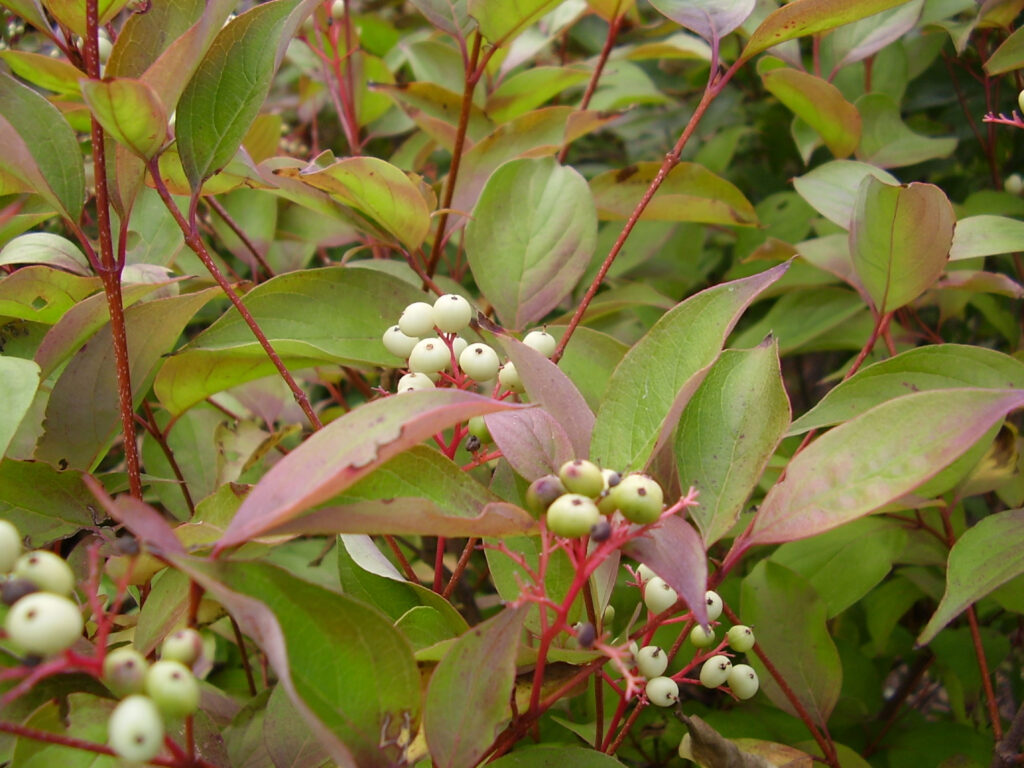By Bonnie Kirn Donahue, Extension Master Gardener, University of Vermont
Dogwoods, in the genus Cornus, are among the most versatile native shrubs. With seasonal interest, tolerance of less-than-perfect conditions, and benefits for wildlife, these shrubs are worth considering.
Planting native dogwoods has many benefits. They flower in the spring, offering food for native insects and pollinators. They set fruit in the fall, feeding many species of birds and mammals.
These plants are also attractive additions to the garden. The leaves have a quilted quality with highly visible veining and strong green leaves. Depending on the variety, berries can be white, purplish-blue, or black.
Unique clusters of tiny white flowers are supported on a bed of green leaves. Some varieties have bright red stems that lighten up the winter landscape, and some varieties have leaves that turn burgundy red in the fall.
Dogwoods require little maintenance. Pruning is unnecessary unless you are trying to keep the shrub at a certain height. Make a mistake and cut back too much? Dogwoods are very forgiving plants that will persist in gardens in spite of it.
Several native varieties of dogwoods can be grown in Vermont, including red-twig dogwood (Cornus sericea), pagoda dogwood (Cornus alternifolia), grey dogwood (Cornus racemosa) and silky dogwood (Cornus amomum).
Each species has different uses in the landscape. Some may be found at commercial nurseries, while others may only be available at native conservation nurseries.
Red twig dogwood (Cornus sericea), also called red osier dogwood, is a landscape powerhouse species of the dogwood genus. This plant is tolerant of wet and dry conditions and partial or full sun. Deer tend to leave them alone, though occasionally nibble the spring buds. This plant likes to spread, so it can be useful in areas that need erosion control, such as riparian areas, but can also compete with other plants if left unmanaged.
The straight species (plant species without cultivars) grows 6 to 9 feet tall and 7 to 10 feet wide. Red twig dogwood has many cultivars available, including some that grow smaller and others with more brilliant stem colors.
If you’re trying to create a more ecologically authentic native garden, choose the straight species. If you are looking for a native plant with certain characteristics, a red twig dogwood cultivar may work well for you.
Pagoda dogwood (Cornus alternifolia) is often found in nature on the edge of woods. This large shrub or small tree has a distinct, airy, horizontal branching pattern that helps it stand out from other plants at the edge of the forest.
Growing 15 to 25 feet tall and 20 to 32 feet wide, the pagoda dogwood can grow in part or full sun with medium moisture requirements. Pink stems hold blue-black fruit propped upright above the dark green, horizontal foliage. The leaves turn a burgundy red in fall.
Grey dogwood (Cornus racemosa) prefers moist to wet soil and full sun to part shade. This plant would be appropriate closer to the water in a riparian buffer planting or in a rain garden. In the fall, round, white berries are presented on pink stems, giving this plant a unique natural look. The grey dogwood grows 10 to 15 feet tall and wide.
Silky dogwood (Cornus amomum) is another species of shrub that prefers medium to wet soil conditions. Like the grey dogwood, this species would do better closer to water, like in a rain garden or wet area. Growing 6 to 12 feet tall and wide, it has more of a natural appearance, so it may be better planted in areas left to naturalize.
Interested in more? Check out your local nursery to see what species of dogwood are available.

Grey dogwood (Cornus racemosa) produces round, white berries on pink stems in the fall. It does best in moist to wet soil and full sun to part shade.




